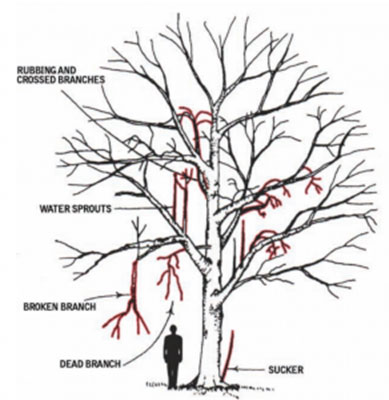- Tree Removal
- Tree Pruning
- MoreHide
Clearance pruning shall include removal of branches to provide a minimum of 2 feet from building/structures, 10 feet over sidewalks, and 6 feet from roofs, 14 feet over roadways. Will not prune if the tree is within 10 ft of power lines.
Pruning shall consist of selective pruning to remove the following: dead, diseased, and/or broken branches over 1” diameter. Prune out lowest sucker growth. Include standard clearance: 2 ft from building and structures, 10 ft over the sidewalk, 6 ft from roofs, and 14 ft over the roadway. Will not prune if the tree is within 10 ft of power lines.
A complete pruning of a tree to improve health, aesthetics, and structure. This includes – hazard reduction pruning, removing deadwood, clearance pruning, remove lowest sucker growth, end weight reduction where necessary, and pruning to address structural defects where possible. All pruning to conform to ANSI-A300 industry pruning standards. Will not prune within 10 ft of overhead power lines.
Head back or remove limbs to increase clearance from buildings, wires, lights, sidewalks, roads, etc.
Standard clearance specifications:
Crown Clean it to include the following: (1) remove dead, broken or diseased limbs 2 inches in diameter or larger; (2) remove rubbing or crossing branches; (3) if two limbs (2-inches diameter or larger) originate within 12 inches of each other on the truck, shorten or remove one of them. (4) Remove weakly attached branches along with suckers and some water sprouts. Do not remove all water sprouts and do not remove only interior branches.
Use directional pruning where possible to future growth is directed away from buildings and lights.
Although small-diameter limbs may occasionally be pruned to gain access into the tree, it will not be necessary to make cuts smaller than 2 inches in diameter, other than where branches may be shortened to accommodate clearance beneath the canopy.
Do not strip out the interior foliage leaving only live branches at the ends of branches.

Under prune to increase ground clearance.
Many trees are over-pruned when the canopy is raised (top right). After proper crown raise, a good goal is to have foliage on branches in the upper 2/3 of the tree (bottom). The live crown ratio should be at least 60%. Small-diameter branches left on the lower trunk for about a year pruning help close pruning would and protect the tree by providing shade to that region. They also help hide pruning wounds.

Prune to reduce both HEIGHT and SPREAD of the tree canopy using reduction cuts to an appropriate lateral. Cut back appropriate laterals (nothing larger than 1/3 the diameter of where the branch is attached) to reduce the height and/or width of a tree. Include deadwood and standard clearance.
Canopy reduction makes a tree smaller by removing the end portion of branches with reduction cute (lower right). Inappropriate reduction uses heading cuts and can result in more problems later (lower left).